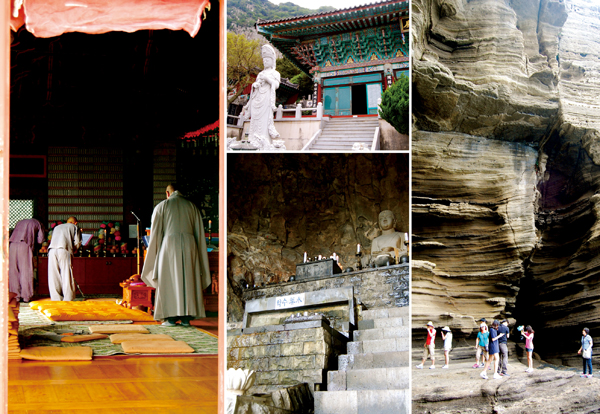
- Updated 2024.4.24 17:16
- All Articles
-
member
icon
-
facebook
cursor
-
twitter
cursor
|
CommunityInterviews |
A grand view of JejuDon't miss the picturesque and family-friendly Sanbangsan and Yongmeori coast |
|
| |
 |
|
| ▲ Sanbangsan and the nearby Yongmeori coast live up to their hype with breathtaking views, geological finds, and a Buddhist temple nestled high up on the lava dome. Photos by Susan Shain |
Legend has it that Sanbangsan, a lava dome rising 395 meters above the sea, was actually the peak of Mt. Halla before it blew off and landed in its current location in Seogwipo.
Today, Sanbangsan is one of the island’s most visited attractions. A few weeks ago I ventured south near Deoksu to see if it warranted such popularity.
I arrived early, around 9 a.m., which I would highly recommend to anyone wanting to avoid the tour bus crowd. By 10:30 a.m., the grounds were swarmed with tourists in neon hiking outfits. The serenity I enjoyed upon my arrival was well worth my early wake-up.
There are several lovely temples on the lower grounds. While I was there, beautiful chants drifted through the air from a monk and some worshippers within. Also gracing the grounds are a massive two-story golden Buddha statue and a series of golden prayer wheels. Everything is situated on a hill, affording amazing views of the ocean below. For a few magical moments, at the foot of the Buddha, I lost myself in the the chanting and the views of the sea.
The Sanbang Temple Grotto, however, is the main attraction. It is one of the 10 “grand views of Jeju” and well worth the steady uphill 10-minute trek.
At the top of the trail is a large cave carved into the rock. It houses a set of stairs leading first to a small pool of water, then to a stone Buddha surrounded by burning candles. A monk was seated at the entrance to the cave, encouraging visitors to go up the steps towards the sculpture.
After seeing other visitors do the same, I drank a cup of water from the pool, which is filled by water dripping from the cave’s ceiling. The crystal clear water is said to be the tears of the goddess Sanbangdeok, who “accepted all the misery and sufferings of the human world” before turning to rock, read a nearby sign.
In addition to drinking from the pool, many visitors placed bills into the donation box and then lit candles or incense. Several mats are available at the foot of the cave for those who wish to pray.
With the welcoming scent of incense hanging heavily, the sound of water steadily dripping into the pool, and the mesmerizing views of the the ocean, the grotto’s aura was enchanting and ethereal — one of the best places I have visited on the island.
Before my visit to Sanbangsan, I was unaware that there are also several other attractions in the same area. They include some sad-looking pony rides and a bizarre recreation of the Sparrowhawk, a Dutch ship that wrecked here in the 17th century. (The outside sign excitedly claims that the explorer, Hendrick Hamel, spent 13 years in Jeju. After a more thorough exploration of the ship, however, I discovered that he was held and enslaved here against his will.)
The most impressive sight is the trail along the Yongmeori coast. A sign says that the coast is a “tuff ring formed by layer-by-layer accumulation of tephra produced by hydrovolcanic explosions.” I have no idea what that means, and I am assuming most readers won’t either. If I may put it into more layman terms: Go to the Yongmeori coast; it’s sweet.
After walking down a steep natural staircase, I found myself on the coast, where rippled cliffs of brown and gray stone appeared to undulate towards and away from me. The contours of the high cliffs are unique, and their appearance is also interesting — highly striated from various layers of sediment. Amidst the infinite nooks and crannies emerges a world of rocks that look positively Dr. Seuss-like. I expected the Korean version of the Lorax to join me at any moment.
Jeju women divers (haenyeo) sat perched along the rocks, offering up their recent catch in colorful plastic buckets. Koreans posed for family pictures and giggled as they tried to avoid being splashed by the waves breaking along the rocks. I picked my way along the shore, and after a pleasant 15-minute exploration, ended up at the exit on the other end.
I would highly recommend making a combined visit to Sanbangsan and the Yongmeori coast. Not only is it beautiful and peaceful, but it would make a wonderful family outing as it is absolutely free for Jeju residents, including those with Jeju Alien Registration Cards.
Sanbangsan and Yong-meori coast
Admission fee: Adults - 2,000 won, Jeju residents (including Jeju ARC-holders) - Free, Children/Youth (up to 24 years old) - 1,500 won
From Jeju City, take the Moseulpo bus and get off at Sanbangsan. If driving from Jeju City, take 1135 south, then turn left on 1121.
|
|
|
|
|
|
|
|
ⓒ Jeju Weekly 2009 (http://www.jejuweekly.net)
All materials on this site are protected under the Korean Copyright Law and may not be reproduced, distributed, transmitted, displayed, published without the prior consent of Jeju Weekly. |
|
|
|
|
| Jeju-Asia's No.1 for Cruise |
|
|
|
Title:The jeju Weekly(제주위클리) | Mail to editor@jejuweekly.net | Phone: +82-64-724-7776 Fax: +82-64-724-7796
#503, 36-1, Seogwang-ro, Jeju-si, Jeju-do, Korea, 63148
Registration Number: Jeju, Ah01158(제주,아01158) | Date of Registration: November 10,2022 | Publisher&Editor : Hee Tak Ko | Youth policy: Hee Tak Ko
Copyright ⓒ 2009 All materials on this site are protected under the Korean Copyright Law and may not be reproduced, distributed, transmitted, displayed, published
without the prior consent of jeju weekly.com.

|




















